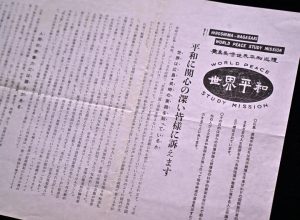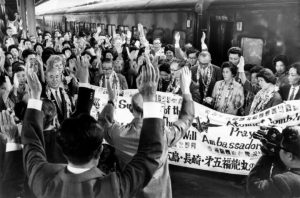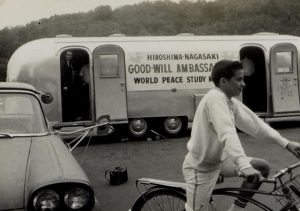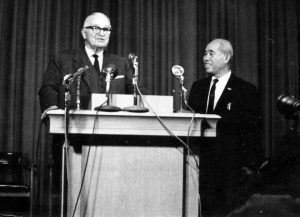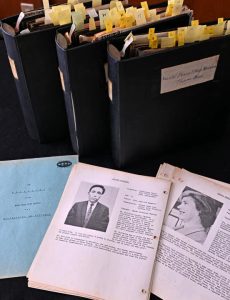Communicating anti-nuclear hopes to the world: 60 years since Hiroshima-Nagasaki World Peace Pilgrimage, a journey of faith, traced through documents
Apr. 29, 2024
by Hiromi Morita, Staff Writer
Sixty years ago, in 1964, the late American peace activist Barbara Reynolds proposed and brought to fruition the “Hiroshima–Nagasaki World Peace Pilgrimage.” A total of 40 people, such as A-bomb survivors, visited eight countries, including nuclear weapons states, over a period of 75 days to communicate the voices of the A-bombed cities. The pilgrimage took place during the Cold War between the United States and the Soviet Union, when the exchange rate stood at 360 yen per dollar. How was such a grand project accomplished? First, this article will roughly trace the footsteps taken on the journey by investigating documents and materials that remain today at the World Friendship Center (WFC), an organization Ms. Reynolds founded in Hiroshima after her return to the United States, as well as those held by people who were involved in the project.
In June 1963, the year before the pilgrimage, Ms. Reynolds sent a proposal for “A Peace Pilgrimage for A-bomb Survivors” to peace activists and organizations in the United States, calling for cooperation in the project. She mentioned that no one would have imagined how powerful the messages from A-bomb survivors were. She added that the importance and depth of their pleas and the pleas’ power to attract attention appeared to have been underestimated.
Before that time, in 1962, Ms. Reynolds had toured the United States, the Soviet Union, and other countries with two A-bomb survivors, including the late Miyoko Matsubara. While sensing a positive response to the anti-nuclear advocacy directly communicated by the A-bomb survivors, those impacted by the bombings, she also experienced a stronger desire to engage in devising more plans for larger-scale and more effective activities.
In response to Ms. Reynold’s proposal, an executive committee (chaired by Tomin Harada) was immediately formed in the A-bombed city of Hiroshima to select members and raise funds. The travel expenses for the pilgrimage delegation and other necessary finances amounted to around 100,000 dollars, or about 36 million yen at the exchange rate at that time. At a time when the average starting salary for college graduates in Japan was around 20,000 yen, the group was seeking funds 10 times that value in today’s yen through a fund-raising campaign carried out in Japan and overseas.
A letter of intent remains at the WFC. It emphasizes that the purpose of the “pilgrimage” was to question the “world’s ignorance concerning the reality brought about by nuclear weapons” and connect the world to the “desperate anger burning in their hearts over the world’s lack of understanding, as well as their desire for peace as witnesses to the horror.”
In the morning edition of the Chugoku Shimbun newspaper dated November 10, 1963, a headline announced that selection guidelines had been decided for the peace pilgrimage participants, who were to communicate the devastation caused by the atomic bombings to the world. According to the article, the participants were to be defined as A-bomb survivors of Hiroshima and Nagasaki who opposed nuclear testing and nuclear armaments by any country and were passionate about the elimination of war and the achievement of world peace from a human standpoint. The criteria also included the ability to converse with intellectuals in the United States and the Soviet Union and to communicate through specialized fields and life experiences.
On January 17, 1964, the first 15 participants from Hiroshima were announced. According to the Chugoku Shimbun article, they were selected from among 74 applicants. The determined participants included Hiromu Morishita, 93, a teacher at Hatsukaichi High School who is now a resident of Hiroshima’s Saeki Ward; and Shizuko Abe, 97, a housewife and farmer who lives in the city’s Minami Ward. Both are still in the possession of the telegram informing them of their selection as participants in the peace pilgrimage.
Other selected members included Ms. Matsubara, who made the pilgrimage in 1962; Takuo Matsumoto, a theologian who experienced the atomic bombing when he was the principal of Hiroshima Jogakuin School; Tokie Kawamoto, facilitator of the Hiroshima Paper Crane Club; and other A-bomb survivors from a variety of backgrounds. Naomi Shono, a physicist and professor at Hiroshima Jogakuin University, and other experts, as well as a reporter from the Chugoku Shimbun, accompanied the tour. The pilgrimage group was composed of a total of around 40 people, including A-bomb survivors from Nagasaki and student interpreters from International Christian University.
Spirit of citizens who provided support through years of funding difficulties, Cold War tensions remains today
There is a banner that often appears in newspaper articles and photographs reporting on the pilgrimage group. This banner is imbued with the hand-written phrase “Voices from Hiroshima, Nagasaki, and Lucky Dragon No. 5 to the world.” It was created by children members of the Hiroshima Paper Crane Club, which was engaged in the efforts to establish the Children’s Peace Monument in Peace Memorial Park and to preserve the A-Bomb Dome, and was entrusted to the pilgrimage group. The banner was completed with the inclusion of the photos of around 120 people, including those from Hiroshima and Nagasaki who had died from aftereffects of the atomic bombings as well as a photo of Aikichi Kuboyama, chief radio operator of the “Lucky Dragon No. 5” fishing boat, who died as a result of a U.S. nuclear test. The Hiroshima Paper Crane Club also cooperated in the fund-raising campaign.
The huge pilgrimage project, which entailed 40 people traveling around the world, required a significant amount of funding. Newspapers at the time reported on fund-raising campaigns by women’s groups, as well as the creation of leaflets describing the realities of the atomic bombings and the translation of A-bomb survivors’ personal accounts into English, both of which were to be entrusted to the pilgrimage group. The Hiroshima City government also cooperated by lending out A-bomb materials. The April 13 Chugoku Shimbun article, which was published just prior to the group’s departure, devoted one page to a round-table discussion titled “Peace Pilgrimage: Our Appeal.” The newspaper carried a submission written by Shinso Hamai, the mayor of Hiroshima at the time. The project can truly be described as resulting from the efforts of the entire A-bombed city.
For many of the members, the pilgrimage was their first trip abroad. After leaving Hiroshima and arriving at Odawara, a city in Japan’s Kanagawa Prefecture, early the following morning, the pilgrimage members stayed in Hakone until April 20 for a preliminary study session. Ms. Abe wrote in her travel diary at the time that a number of ambassadors to Japan provided explanations about the reality of their countries and that lecturers had been invited to give presentations about the atomic bombings from a medical perspective.
The Cold War era was a trying period. Press reports at the time and remaining records reveal that the United States was particularly wary of communism and socialism. Mr. Harada, head of the executive committee, revealed in the Chugoku Shimbun newspaper that, “When selecting members, local host organizations imposed conditions on participants to ensure that any political overtones would be excluded, regardless of whether they were on the left or right.”
Probably for that reason, the issuance of Mr. Shono’s visa was put on hold and he was unable to travel to the United States with the group. Without Mr. Shono, the group arrived in Hawaii on April 21. The participants then divided into three teams and departed for the U.S. mainland and Canada. After that, the entire group visited East and West Germany, Belgium, the Soviet Union, and other countries. Mr. Shono was able to rejoin the pilgrimage in the United States.
In each country, there were local organizations that played host to the pilgrimage group. However, in the United States, the country that had dropped the atomic bombs on Japan, the pilgrimage apparently did not go off without a hitch. It became entangled in right-wing protests, and the windows displaying A-bomb related materials were broken.
The team including Ms. Abe and Mr. Morishita met with Harry Truman, U.S. president at the time of the atomic bombings, at the Harry S. Truman Presidential Library in the U.S. state of Missouri. However, the meeting lasted just three minutes. Mr. Truman stated the conventional stance that the purpose for using the atomic bombs was to end the war and that there had been no alternative. The team was reported to have let out a collective sigh.
Another obstacle for the pilgrimage group was funding. They asked for donations wherever they went and tried to save money by asking to be allowed to stay in private homes or in student dormitories. They were supported by well-intentioned people; Ms. Reynolds also spent her own money. Even still, their financial situation was tenuous.
For that reason, some suggested that instead of the entire group traveling from the U.S. to Europe and the Soviet Union, it might be better to send only representatives. Despite that view, Ms. Reynolds insisted that all group members make the trip. She had expensive airline tickets paid back and instead chose an inexpensive land route for their travel to Moscow. For their return to Japan, they traveled by ship from the Russian city of Nakhodka, arriving in Yokohama on July 4.
In 1965, the following year, Ms. Reynolds founded the WFC organization in Hiroshima together with Mr. Harada in the hopes of creating a space where people with diverse backgrounds from throughout the world could share their opinions and that would serve as a bridge between Hiroshima and the world. Her idea continues to this day.
In April of this year, the WFC held a commemorative panel exhibit in Hiroshima’s Naka Ward, using photos and materials to convey the vitality of the grassroot activities at the time of the pilgrimage. WFC Chair Shizuo Tachibana said with conviction, “We’d like this exhibit to provide citizens of the A-bombed city with the opportunity to think about what they can do.” Mr. Morishita, honorary chair of the organization, visited the venue and said, “The Cold War was a difficult time. However, the current world situation has become even more serious. That is exactly why we must inform people of the situation in those days and speak out.”
(Originally published on April 29, 2024)
Sixty years ago, in 1964, the late American peace activist Barbara Reynolds proposed and brought to fruition the “Hiroshima–Nagasaki World Peace Pilgrimage.” A total of 40 people, such as A-bomb survivors, visited eight countries, including nuclear weapons states, over a period of 75 days to communicate the voices of the A-bombed cities. The pilgrimage took place during the Cold War between the United States and the Soviet Union, when the exchange rate stood at 360 yen per dollar. How was such a grand project accomplished? First, this article will roughly trace the footsteps taken on the journey by investigating documents and materials that remain today at the World Friendship Center (WFC), an organization Ms. Reynolds founded in Hiroshima after her return to the United States, as well as those held by people who were involved in the project.
Forty A-bomb survivors and citizens selected to call on eight countries
In June 1963, the year before the pilgrimage, Ms. Reynolds sent a proposal for “A Peace Pilgrimage for A-bomb Survivors” to peace activists and organizations in the United States, calling for cooperation in the project. She mentioned that no one would have imagined how powerful the messages from A-bomb survivors were. She added that the importance and depth of their pleas and the pleas’ power to attract attention appeared to have been underestimated.
Before that time, in 1962, Ms. Reynolds had toured the United States, the Soviet Union, and other countries with two A-bomb survivors, including the late Miyoko Matsubara. While sensing a positive response to the anti-nuclear advocacy directly communicated by the A-bomb survivors, those impacted by the bombings, she also experienced a stronger desire to engage in devising more plans for larger-scale and more effective activities.
In response to Ms. Reynold’s proposal, an executive committee (chaired by Tomin Harada) was immediately formed in the A-bombed city of Hiroshima to select members and raise funds. The travel expenses for the pilgrimage delegation and other necessary finances amounted to around 100,000 dollars, or about 36 million yen at the exchange rate at that time. At a time when the average starting salary for college graduates in Japan was around 20,000 yen, the group was seeking funds 10 times that value in today’s yen through a fund-raising campaign carried out in Japan and overseas.
A letter of intent remains at the WFC. It emphasizes that the purpose of the “pilgrimage” was to question the “world’s ignorance concerning the reality brought about by nuclear weapons” and connect the world to the “desperate anger burning in their hearts over the world’s lack of understanding, as well as their desire for peace as witnesses to the horror.”
In the morning edition of the Chugoku Shimbun newspaper dated November 10, 1963, a headline announced that selection guidelines had been decided for the peace pilgrimage participants, who were to communicate the devastation caused by the atomic bombings to the world. According to the article, the participants were to be defined as A-bomb survivors of Hiroshima and Nagasaki who opposed nuclear testing and nuclear armaments by any country and were passionate about the elimination of war and the achievement of world peace from a human standpoint. The criteria also included the ability to converse with intellectuals in the United States and the Soviet Union and to communicate through specialized fields and life experiences.
On January 17, 1964, the first 15 participants from Hiroshima were announced. According to the Chugoku Shimbun article, they were selected from among 74 applicants. The determined participants included Hiromu Morishita, 93, a teacher at Hatsukaichi High School who is now a resident of Hiroshima’s Saeki Ward; and Shizuko Abe, 97, a housewife and farmer who lives in the city’s Minami Ward. Both are still in the possession of the telegram informing them of their selection as participants in the peace pilgrimage.
Other selected members included Ms. Matsubara, who made the pilgrimage in 1962; Takuo Matsumoto, a theologian who experienced the atomic bombing when he was the principal of Hiroshima Jogakuin School; Tokie Kawamoto, facilitator of the Hiroshima Paper Crane Club; and other A-bomb survivors from a variety of backgrounds. Naomi Shono, a physicist and professor at Hiroshima Jogakuin University, and other experts, as well as a reporter from the Chugoku Shimbun, accompanied the tour. The pilgrimage group was composed of a total of around 40 people, including A-bomb survivors from Nagasaki and student interpreters from International Christian University.
Spirit of citizens who provided support through years of funding difficulties, Cold War tensions remains today
There is a banner that often appears in newspaper articles and photographs reporting on the pilgrimage group. This banner is imbued with the hand-written phrase “Voices from Hiroshima, Nagasaki, and Lucky Dragon No. 5 to the world.” It was created by children members of the Hiroshima Paper Crane Club, which was engaged in the efforts to establish the Children’s Peace Monument in Peace Memorial Park and to preserve the A-Bomb Dome, and was entrusted to the pilgrimage group. The banner was completed with the inclusion of the photos of around 120 people, including those from Hiroshima and Nagasaki who had died from aftereffects of the atomic bombings as well as a photo of Aikichi Kuboyama, chief radio operator of the “Lucky Dragon No. 5” fishing boat, who died as a result of a U.S. nuclear test. The Hiroshima Paper Crane Club also cooperated in the fund-raising campaign.
The huge pilgrimage project, which entailed 40 people traveling around the world, required a significant amount of funding. Newspapers at the time reported on fund-raising campaigns by women’s groups, as well as the creation of leaflets describing the realities of the atomic bombings and the translation of A-bomb survivors’ personal accounts into English, both of which were to be entrusted to the pilgrimage group. The Hiroshima City government also cooperated by lending out A-bomb materials. The April 13 Chugoku Shimbun article, which was published just prior to the group’s departure, devoted one page to a round-table discussion titled “Peace Pilgrimage: Our Appeal.” The newspaper carried a submission written by Shinso Hamai, the mayor of Hiroshima at the time. The project can truly be described as resulting from the efforts of the entire A-bombed city.
For many of the members, the pilgrimage was their first trip abroad. After leaving Hiroshima and arriving at Odawara, a city in Japan’s Kanagawa Prefecture, early the following morning, the pilgrimage members stayed in Hakone until April 20 for a preliminary study session. Ms. Abe wrote in her travel diary at the time that a number of ambassadors to Japan provided explanations about the reality of their countries and that lecturers had been invited to give presentations about the atomic bombings from a medical perspective.
The Cold War era was a trying period. Press reports at the time and remaining records reveal that the United States was particularly wary of communism and socialism. Mr. Harada, head of the executive committee, revealed in the Chugoku Shimbun newspaper that, “When selecting members, local host organizations imposed conditions on participants to ensure that any political overtones would be excluded, regardless of whether they were on the left or right.”
Probably for that reason, the issuance of Mr. Shono’s visa was put on hold and he was unable to travel to the United States with the group. Without Mr. Shono, the group arrived in Hawaii on April 21. The participants then divided into three teams and departed for the U.S. mainland and Canada. After that, the entire group visited East and West Germany, Belgium, the Soviet Union, and other countries. Mr. Shono was able to rejoin the pilgrimage in the United States.
In each country, there were local organizations that played host to the pilgrimage group. However, in the United States, the country that had dropped the atomic bombs on Japan, the pilgrimage apparently did not go off without a hitch. It became entangled in right-wing protests, and the windows displaying A-bomb related materials were broken.
The team including Ms. Abe and Mr. Morishita met with Harry Truman, U.S. president at the time of the atomic bombings, at the Harry S. Truman Presidential Library in the U.S. state of Missouri. However, the meeting lasted just three minutes. Mr. Truman stated the conventional stance that the purpose for using the atomic bombs was to end the war and that there had been no alternative. The team was reported to have let out a collective sigh.
Another obstacle for the pilgrimage group was funding. They asked for donations wherever they went and tried to save money by asking to be allowed to stay in private homes or in student dormitories. They were supported by well-intentioned people; Ms. Reynolds also spent her own money. Even still, their financial situation was tenuous.
For that reason, some suggested that instead of the entire group traveling from the U.S. to Europe and the Soviet Union, it might be better to send only representatives. Despite that view, Ms. Reynolds insisted that all group members make the trip. She had expensive airline tickets paid back and instead chose an inexpensive land route for their travel to Moscow. For their return to Japan, they traveled by ship from the Russian city of Nakhodka, arriving in Yokohama on July 4.
In 1965, the following year, Ms. Reynolds founded the WFC organization in Hiroshima together with Mr. Harada in the hopes of creating a space where people with diverse backgrounds from throughout the world could share their opinions and that would serve as a bridge between Hiroshima and the world. Her idea continues to this day.
In April of this year, the WFC held a commemorative panel exhibit in Hiroshima’s Naka Ward, using photos and materials to convey the vitality of the grassroot activities at the time of the pilgrimage. WFC Chair Shizuo Tachibana said with conviction, “We’d like this exhibit to provide citizens of the A-bombed city with the opportunity to think about what they can do.” Mr. Morishita, honorary chair of the organization, visited the venue and said, “The Cold War was a difficult time. However, the current world situation has become even more serious. That is exactly why we must inform people of the situation in those days and speak out.”
(Originally published on April 29, 2024)

